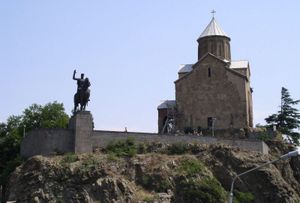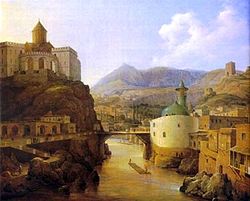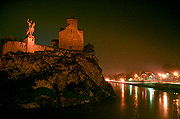
Metekhi
Encyclopedia

Tbilisi
Tbilisi is the capital and the largest city of Georgia, lying on the banks of the Mt'k'vari River. The name is derived from an early Georgian form T'pilisi and it was officially known as Tiflis until 1936...
, Georgia
Georgia (country)
Georgia is a sovereign state in the Caucasus region of Eurasia. Located at the crossroads of Western Asia and Eastern Europe, it is bounded to the west by the Black Sea, to the north by Russia, to the southwest by Turkey, to the south by Armenia, and to the southeast by Azerbaijan. The capital of...
, located on the elevated cliff that overlooks the Mtkvari river.
History
The district was one of the earliest inhabited areas on the city’s territory. According to traditional accounts, King Vakhtang I Gorgasali erected here a church and a fort which served also as a king’s residence; hence comes the name Metekhi which dates back to the 12th century and literally means “the area around the palace”. Tradition holds that it was also a site where the 5th-century martyr lady Saint ShushanikShushanik
Saint Shushanik was a Christian woman who was murdered by her husband Varsken in the town of Tsurtavi, Georgia. Since she died defending her right to profess Christianity, she is regarded as a martyr...
was buried. However, none of these structures have survived the Mongol
Mongol Empire
The Mongol Empire , initially named as Greater Mongol State was a great empire during the 13th and 14th centuries...
invasion of 1235.

Assumption of Mary
According to the belief of Christians of the Roman Catholic Church, Eastern Orthodoxy, Oriental Orthodoxy, and parts of the Anglican Communion and Continuing Anglicanism, the Assumption of Mary was the bodily taking up of the Virgin Mary into Heaven at the end of her life...
, resting upon the top of the hill, was built by the Georgian king St Demetrius II
Demetre II of Georgia
Saint King Demetrius II the Self-sacrificer , from the Bagrationi dynasty, was king of Georgia in 1270–1289.-Life:...
circa 1278–1284 and is somewhat an unusual example of domed Georgian Orthodox church. It was later damaged and restored several times. King Rostom
Rostom of Kartli
Rostom or Rustam Khan was a ruler of Kartli, eastern Georgia, from 1633 until his death. Appointed by a Persian shah as a Wāli of Kartli, he styled himself king of kings and sovereign.- Life :...
(r. 1633-1658) fortified the area around the church with a strong citadel garrisoned by some 3,000 soldiers. Under the Russian rule (established in 1801), the church lost its religious purpose and was used as a barracks (R. G. Suny, p. 93). The citadel was demolished in 1819 and replaced by a new building which functioned as the infamous jail down to the Soviet
Soviet Union
The Soviet Union , officially the Union of Soviet Socialist Republics , was a constitutionally socialist state that existed in Eurasia between 1922 and 1991....
era, and was closed only in 1938.

Communist party
A political party described as a Communist party includes those that advocate the application of the social principles of communism through a communist form of government...
chief Lavrenti Pavlovich Beria intended to destroy the church as well, but met a stubborn opposition by a group of Georgian
Georgia (country)
Georgia is a sovereign state in the Caucasus region of Eurasia. Located at the crossroads of Western Asia and Eastern Europe, it is bounded to the west by the Black Sea, to the north by Russia, to the southwest by Turkey, to the south by Armenia, and to the southeast by Azerbaijan. The capital of...
intellectuals led by the painter and art collector Dimitri Shevardnadze
Dimitri Shevardnadze
Dimitri Shevardnadze was a Georgian painter, art collector and intellectual purged during the Stalinist repressions....
. Beria replied to their urges, that it would surely be enough to preserve a scale model of the church so that people could see it in a museum, and then is said to have told Shevardnadze privately that if he gave up his efforts to save the church he would be appointed director of the future museum. The artist refused and was imprisoned and executed (Ami Knight, p. 84). The building was preserved, however. In the later part of Soviet period the church was used as a theatre. The equestrian statue of King Vakhtang I Gorgaslan by the sculptor Elguja Amashukeli was erected in front of the church in 1961.
In the late 1980s, Catholicos-Patriarch of All Georgia
Catholicos-Patriarch of All Georgia
Catholicos–Patriarch has been the title of the heads of the Georgian Orthodox Church since 1010. The first Catholicos–Patriarch of All Georgia was Melkisedek I...
Ilia II
Ilia II
Ilia II is the current Catholicos-Patriarch of All Georgia and the spiritual leader of the Georgian Orthodox Church...
launched a popularly supported campaign aiming at the restoration of the church to the Georgian Patriarchate. A well-known dissident and the future president of Georgia
President of Georgia
The President of Georgia is the head of state, supreme commander-in-chief and holder of the highest office within the Government of Georgia. Executive power is split between the President and the Prime Minister, who is the head of government...
Zviad Gamsakhurdia
Zviad Gamsakhurdia
Zviad Gamsakhurdia was a dissident, scientist and writer, who became the first democratically elected President of the Republic of Georgia in the post-Soviet era...
went on a hunger strike in support of this demand. Despite initial resistance from the local Communist leadership, the church became functioning again in 1988.
Architecture

Legend has it also that the Metekhi cliff was a site of the martyrdom of Habo (8th century), Tbilisi
Tbilisi
Tbilisi is the capital and the largest city of Georgia, lying on the banks of the Mt'k'vari River. The name is derived from an early Georgian form T'pilisi and it was officially known as Tiflis until 1936...
’s patron saint. A small church in his honor is now under construction at the foot of the cliff.
The cliff is connected to the opposite, right embankment of the Mtkvari river, via a reinforced concrete bridge, which was constructed in 1951 at the place of the two older bridges. Unfortunately, a unique complex of various structures and buildings dating from the 17th to 19th centuries were destroyed during the construction of the bridge. Recently, the city’s government enounced its intention to restore this part of historic Old Tbilisi as it was in the first half of the 20th century.
External links
- Georgia attractions at Sheraton Metechi Palace HotelSheraton Metechi Palace HotelThe Sheraton Metechi Palace Hotel is a five-star hotel in Tbilisi, in Georgia. It is located in the city center of Tbilisi, near central business district. Is run by Sheraton Hotels and Resorts. The hotel is opened in 1989.-External links:*...
website

